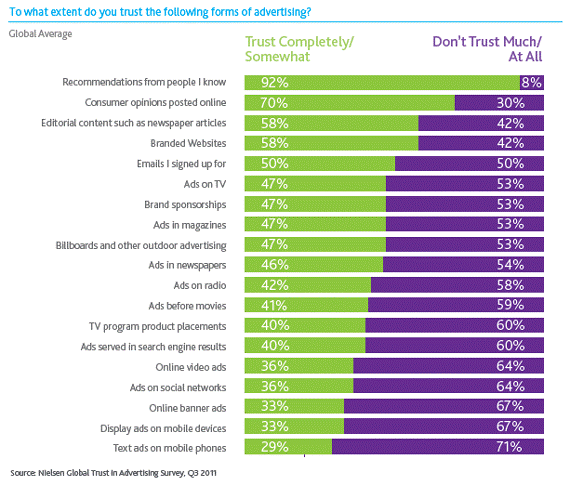6 Examples of Using Social Proof in Advertising
Last edited: February 13th, 2024

Using social proof in advertising is more versatile than you even thought. Let’s go over:
- Why social proof generates more leads and sales
- What is the role of online reviews
- Examples in advertising that work
Why Social Proof Works in Advertising
Social proof is a term that’s gained a lot of popularity in recent years and is most often associated with online marketing. However, as a psychological idea it goes back much farther than this, and is a concept as old as human society itself.
At its core, social proof is all about trust. As human beings we’re wired to trust the opinions of our friends and neighbours, and as we’ve moved into the internet age this has spilled over into trusting online reviews and testimonials.
In fact, social proof is so strong that research has shown that 92% of people would trust a recommendation from a friend, 70% would trust online reviews, but only 40% would trust a paid advertisement. So, it’s undeniable that social proof is important in marketing your product, but how can you use social proof in advertising effectively? We break down 6 ways you can.

6 Types of Social Proof to Use in Advertising
1. User testimonials
This is probably one of the most common ways to use social proof in advertising. This is a genuine endorsement of your product or service and is up there in the 70% trust range. User testimonials can come from a few different sources:
- On your company website with testimonial and review widgets
- Via social media comments
- Review aggregator sites like Trustpilot
Where possible, try and encourage your customers to leave testimonials and reviews in as many places as possible.
The more positive reviews you have, the more people trust your product and the greater your social proof.
Looking for a tool to collect testimonials? Try the free version of our software!
2. Expert social proof
This type of social proof stems from the innate trust we place in authority figures and experts. This can be a little more difficult to obtain, as it involves reaching out to industry experts, but it’s an advertising strategy that can pay dividends.
We’ve actually seen this done for years in the dental industry. Who of us hasn’t seen one of those toothpaste adverts that claims “9 out of 10 dentists would recommend this toothpaste!”.
Of course you’ll need to be a little more sophisticated today. Some larger companies are able to involve experts in their research and development process of new products and can post updates to social media.
Smaller organizations can reach out to experts with large social media followings, and offer free trials of their products. If the experts are impressed, they’ll spread the good word.
3. Business credentials
This is another type of social proof in advertising that adds trust to your product. When people see how many others have placed their trust in you, they’re sure to follow suit. Let’s be honest, which would you trust more? The business that has serviced thousands of happy customers, or a brand new start up? People are much more likely to go with the one that has the most credentials.
Some good credentials you can shout about include:
- Total number of customers over the lifetime of your business
- Any big name clients your business serves
- Number of positive online reviews
- Any industry awards you’ve won
- Government accreditations for quality
- Variety of products you sell

This type of social proof is generally used more by established businesses, as the longer you’ve been trading, the more time you’ve had to build up a reputation. Make sure you get these positive stats on your website.
4. FOMO – The fear of missing out
You might have heard of FOMO, or the fear of missing out. It’s a relatively new term, but the ideas behind it are quite old. Essentially, us humans don’t want to miss out on what the crowd is doing. If we see a group of people flocking towards a certain place, product or service, others are likely to follow.
But how do you use FOMO as social proof in advertising? Well, you need to convince people they’re missing out on one of your products that everyone else is enjoying. This can be done in the following ways:
- Use limited time offers. Timed sales and events are a real encouragement to make sales. Just look at offers like Black Friday, or Amazon Prime Day as examples.
- Give examples of customers who acted quickly in the past and how they benefited from getting in early. Always ask your customers permission first though before using their example in advertising.
- Use exit pop ups on your website. Just as a customer is about to leave your website without purchasing, you can add an exit pop up. This will give your customer a last minute offer or discount, and hopefully persuade them to stay.
You may also want to check out these 7 real examples you can copy for your FOMO advertising.
5. Celebrity endorsements
This is a new form of social proof that has grown with the rise of Instagram and social influencers. While you can pay social media influencers and celebrities to endorse your product, it’ll be much more meaningful if you can get a natural endorsement.
Similar to getting social proof from experts, you can reach out to celebrities and influencers who might have an interest in your product, offer it to them for free, and if they like it you should get an endorsement.
6. Gazing
Gazing is a social proof advertising tactic that is becoming more and more popular. This is a method that’s used to attract customer’s gaze to a certain product and is used heavily in social media marketing. It’s based on our tendency to stare at something interesting or exciting.
This can be done by making engaging content and posting it to social media sites. People are naturally more drawn to videos and images, and these types of posts get far more traction on social media than others.
You can also apply gazing on a more basic level on your website. Make routes to purchase or sign up to email lists as obvious as possible, and use people’s natural gazing habits to attract attention where you want it.
Gazing can be enhanced by incorporating pay-per-click advertising, but you would need to have a suitable plan for implementing such advertising tactics. You may seek advice from any PPC campaign management provider or simply experiment with small quantities to better understand how your audience reacts.
6 Examples of Using Social Proof in Advertising
Get inspired by these 6 strategies that will have a huge impact on your . We recommend trying them all out to see what are the best ways for you to use social proof in Facebook ads, your landing page, or wherever!
These social proof examples work for all companies and not just ecommerce brands.
Example #1: Using Video Testimonials
By implementing video testimonials, you’ll be able actually let your customers speak for you. Below you can see what one of Trustmary’s customers, Björn Freudenthal from Puustelli USA has to say about working with Trustmary.
If you want to see similar videos, but of your company, here are three free remote video testimonial templates you can copy!
Example #2: TikTok
Influencer marketing is not dead. In fact, it’s getting even more important than ever with the rise of new medias like TikTok.
How many #honestreview videos have you seen on TikTok? Or the “I bought it from Amazon, so you don’t have to“?
If someone recommends your product or service on said types of videos and happens to find it useful, you’ll definitely see that in your sales numbers.
This form of user social proof is a golden opportunity for small businesses. However, you can’t use the content in your marketing if you don’t have the permission from the creator!
Example #3: YouTube and Micro-influencers
A micro-influencer is someone who has between 1,000 and 100.000 followers on a social media platform. The reason why they are great to collaborate with is that they have a very narrow niche topic they post about. That leads to having a very niche audience as well.
Lately, we’ve seen many companies collaborating with micro-influencers especially on YouTube. They are often called the sponsor of the video and their product or service is explained to the followers.
If you decide to opt for influencer collaboration, don’t forget to gauge the performance of each post with social media analytics tools.
Why do companies collaborate with micro-influencers?
Because micro-influencers have already built a community, it’s easy to tap into that! Especially so, if the values of your company are in line with the influencer in question. Furthermore, the audience is likely to relate to the problems the influencer is having, so it’s a very hot market to advertise a specific solution to.
When we see a person that we relate to trying out a product or service and telling the pros and cons, we’re very likely to purchase the advertised item. This is all thanks to the psychological phenomenon called social proof!
Example #4: Use All Your Reviews and Testimonials
You probably have social proof and online reviews scattered all over different social media platforms and third party review sites.
With Trustmary, you can import reviews and embed them to your website! A great example of how to do this is Windward Software Inc. They’ve imported their reviews and embedded them to their website with a testimonial wall.

Example #5: Popup Lead Generation
When you supercharge your popup lead generation forms with social proof, you’re getting really close to finding the holy grail of organic growth.

Here are some real-life results:
Example #6: User Generated Content (UGC)
User generated content includes both celebrity social proof as well as non-celebrity content.
Try generating a UGC campaign where people can take part in winning a prize if they provide you with a review, testimonial or video testimonial. Remember to make sure that you can then publish the gathered comments!
By using a testimonial tool such a Trustmary, you can automate the whole process of asking for testimonials. No campaigns needed.
This works also for B2B companies, if you use your CRM correctly. Trustmary can be integrated with most CRMs, including Pipedrive and HubSpot.
Word of Caution: Remember to Communicate Openly!
When you start using social proof in your advertising, you should be prepared that people actually reach out back to you.
Aim to respond and react to each comment you get in a timely manner. We mean within 24-48 hours. If you’re able to get reactions, nurture the connection by all means available!
Short checklist of aspects to consider:
- Respond to positive reviews
- Answer to negative comments
- Thank for all feedback!
- Answer questions and ask follow-ups if needed
If you fail to react to comments in your ads, you’ll most probably lose potential customers. People want to hear back when they’ve taken the time to comment!
Things to remember
These are just a few of the tips and tricks you can use for effective social proof in advertising. There are many more out there so feel free to mix and match to find a marketing mix that suits you. Here’s 4 best examples of using testimonials in marketing.
Always remember the importance of your customer reviews though. We’d say that this is the most important aspect of social proof, so try and encourage as many reviews, recommendations and testimonials as possible.
